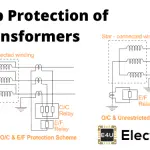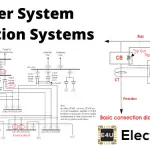Distance Protection Relay
One of the important protections inPower System ProtectionisFeeder Protection.
Differenttypes of relaysare used for feeder protection likeelectromagnetic type relays, static type relays etc. But now a day we are using Numerical relays for all protections.
The benefits of Numerical relays are,
- Accurate tripping,
- Less tolerance,
- Fault events and counter storage
- Display of fault parameters on screen
(Fault parameters means current, voltage,resistanceand reactance values during fault and fault distance, Numerical relays can store thousands of tripping events).
The main inputs needed for distance protection isVoltageandCurrentfrom corresponding feederPTandCT.
According to site conditions we will set certain impedance values inrelay settings(i.e., R and X values) for fault detection. Relay will monitor Current and Voltage in the feeder line (PT and CT secondary), and from these values, the relay will calculate Impedance value Z. i.e., Z = V/I. In normal load condition the impedance values on line will be high. But when fault comes on the feeder line, the impedance will decrease and becomes less than the impedance setting in the relay, then the distance relay will trip with in 40 ms in zone 1 (different zones are there and that will be explained later) and isolate power equipments from fault. I.e., during fault, relay will trip and show the fault parameters like fault current, voltage, reactance,resistanceand fault distance on relay screen.
Suppose if the fault is on 25 km, then relay will show Fault Distance (FD) = 25km, and thus it becomes easy to identify the location where there is fault. ForDistance protectionnow a day Quadrilateral characteristics is used. We already discussed that for fault identification we have to set different parameters in relay. i.e.,
- Forward and Backward Resistance (RF, RB),
- Forward and backward Reactance (XF, XB),
- RCA (Relay Characteristics Angle) and
- Line Impedance per km.
These parameters are used for making Quadrilateral characteristics. Suppose if RCA = 70oand by using parallelogram characteristics (Quadrilateral), we can plot the graph by setting Forward Resistance (RF) value in positive X axis, Backward Resistance (RB) in negative X axis, Forward Reactance (XF) value in positive Y axis, and Backward Reactance (XB) in negative Y axis and plot parallelogram with a slope of RCA angle.
Thus we will get a parallelogram graph and the protection zone is inside the parallelogram. Means during fault the impedance will reach inside the parallelogram then the relay will trip. In graph there are 4 quadrants of operation
- First quadrant (R and X values + ve)
如果负载电感和fault is in forward direction from Relay, then the relay will trip in this quadrant values. - Second quadrant (R – ve and X + ve)
如果负载capacitive and the fault is in reverse direction from Relay, then the relay will trip in this quadrant values. - Third quadrant (R – ve and X – ve)
如果负载电感和fault is in reverse direction from Relay, then the relay will trip in this quadrant values. - Fourth quadrant (R + ve and X – ve)
如果负载capacitive and the fault is in forward direction from Relay, then the relay will trip in this quadrant values.
Different Zones of operation, fault distance calculation and other feeder protection relays etc. will be explained in next article…
Remark:
A model of quadrilateral characteristics is shown below….









